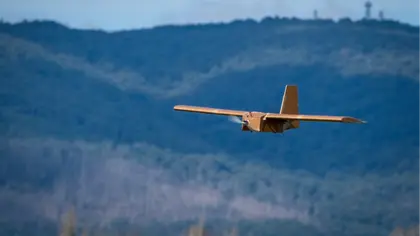A recent Ukrainian drone raid on a military airfield well inside Russia cleared the base of combat aircraft and was a new embarrassment to Kremlin claims the national airspace is impenetrable, but hard proof of Australian drones launched by behind-the-lines agents carried out the attack is limited.
Ukraine’s national intelligence agency the SBU on Sunday in comments to Kyiv Post said strike drones launched by its operatives hit the military territory of Kursk regional airport in a nighttime raid, damaging four Su-30 fighter jets, one MiG-29 fighter jet, two Pantsir-S1 close-range air defense systems and a radar from a long-range S-300 surface-to-air missile system.
- See the most recently published Ukraine news reports from today.
- See the most recently published Ukraine news reports from today.
JOIN US ON TELEGRAM
Follow our coverage of the war on the @Kyivpost_official.
According to an unnamed SBU officer speaking to the RBC-Ukraine news platform, 16 drones were used in the attack of which 3 were shot down. Operators from the SBU’s 13th Division, Counterintelligence carried out the strike, he said.
Russia’s Defense Ministry acknowledged the attack took place. Saturday afternoon videos of multiple explosions in the vicinity of Kursk air base were widely circulating in Russian social media. Usually between 10 and 15 distinct explosions were reported.
A military source told Kyiv Post “several dozen” Russian service personnel were killed or wounded, and ammunition storage facilities and military equipment was “seriously damaged.” In the immediate wake of the attack, the type of drone used by the Ukrainians was not made public.

Russia Closes Airports Amid Widespread Drone Attacks as Ukraine Repels Massive UAV Assault
On Saturday afternoon the Russian military blogger Fighterbomber published an article stating Australia-manufactured SYPAQ drones carried out the strikes, crediting their wooden construction and small size for successful penetration of the airfield’s dense air defenses.
The Kursk airfield’s air defense network, he wrote, included “standard” jammers of the GPS and Starlink satellite systems, multiple vehicle-mounted Pantsir missile/cannon systems, searchlights and machine guns equipped with night-vision devices and tracer ammunition.
In past Ukrainian attacks on similarly defended air bases deep inside Russia, useful hits by the Armed Forces of Ukraine’s (AFU) preferred weapon, a Chinese-made Murgin-5 commercial drone modified to carry explosives, and the size of a small airplane, have typically been limited to one or two impacts. Practically all other drones operated by Ukraine lack the range to hit targets well inside Russia.
Pro-Kremlin information platforms on Monday and Tuesday claimed the strike was ineffective and that subsequent commercial satellite images of the base proved no damage to any aircraft or facilities.
Tyler Rogoway, an aviation analyst, said it wasn’t possible to be sure from the satellite photos taken by Planet Labs Inc. whether the strike was successful or failed. As of Monday, Aug. 28, the Kursk military airfield was empty of all aircraft, those images showed.
Photo © 2023 Planet Labs inc. All rights reserved. Reprinted by permission. pic.twitter.com/Oyd83xl661
— Tyler Rogoway (@Aviation_Intel) August 28, 2023
As of Tuesday, aside from the Fighterbomber report, no source had corroborated that SYPAQs had carried out the Kursk airfield attack.
As a drone flies Kursk airport and its military airfield are some 100-120 km distant from Ukraine-controlled territory. If SYPAQ drones hit the Kursk military airfield, they almost certainly were launched by Ukrainian agents from a site or sites inside Ukraine’s Sumy region proximate to the heavily militarized Russian border or, potentially, from a location inside Russian Federation territory.
In contrast to the Murgin-5 and larger, metal-constructed aircraft, the albatross-sized wooden SYPAQ, an aircraft light enough for a man to pick up easily, is according to military media reports effectively invisible to most if not all Russian air defense systems, which were designed to locate and intercept combat aircraft constructed almost totally out of metal with weights in multiples of tons.
Ukraine’s military started receiving Australian drones in the Spring of 2023. The SYPAQ drone has a maximum payload capacity of 5kg and can stay in the air for 1 to 3 hours depending on payload weight. The drone’s maximum advertised range is 120 kilometers.
Delivery of SKYPAQ drones to Ukraine was announced in Canberra in March 2023 as part of ongoing Australian military assistance to Ukraine. The aircraft was developed in partnership with the Australian Army. Manufactured in Melbourne and delivered to Ukraine disassembled, the kit looks like a package of just-bought IKEA furniture pieces.
To remote-controlled aircraft enthusiasts and model builders, the SYPAQ drone looks very much like a 20th-century balsa wood model plane before gluing it together. By April 2022, Armed Forces of Ukraine (AFU) operators had flown 60 cardboard drone sorties.
The Military TV information platform, in April, reported the AFU would likely use the aircraft for supply delivery, bomb deployment and reconnaissance. Although constructed largely of reinforced cardboard covered with weather-proof wax, the drone reportedly is controlled by a “military grade guidance system that requires no user input,” the report said.
By the standards of the Russo-Ukraine War, where a civilian off-the-shelf drone with limited range can cost $10-50,000 before expensive retrofitting for military use, the Australian cardboard drone’s unit price, ready-to-fly, is cheap: between $670-3,350 (US), depending on mission configuration, the security information news platform Military TV reported.
In March 2023, The Australian newspaper reported Ukraine would receive 100 cardboard drone kits a month.
The Australian system by some metrics compares favorably with the US-made Switchblade 300 drone, a smaller and more sophisticated aircraft but with a shorter 10 km. range, and a cost of $6,000 a piece, not including a $50,000 launcher.
Ukrainian army S-300 operators have told Kyiv Post troops consider the American system relatively user-friendly and more likely to score a hit thanks to semi-autonomous targeting technology but limited in range and equipped with a warhead too small to reliably damage Russian army armored vehicles or troops in bunkers.
You can also highlight the text and press Ctrl + Enter








